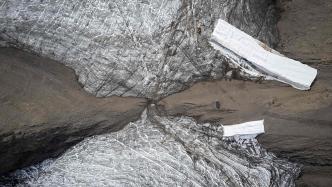
How will Earth's glaciers evolve in the 21st century? This issue determines the magnitude of sea level rise and is critical to the global response to and adaptation to climate change. In new research published today in the journal Science, an international team led by the Toulouse Space Geophysics and Oceanography Research Laboratory in France reveals greater glacier mass loss than previously predicted, with global temperature rise linked to glacier mass loss There is a linear relationship between them.

On September 13, 2022 local time, in Les Diablerets, Switzerland, the Tsanfleuron pass was covered by melting ice for at least 2,000 years. People's Vision Data Map
According to the team's research, by the end of this century, the mass of all 215,000 glaciers on Earth (excluding Greenland and Antarctic ice sheets) may be reduced by 26% to 41% compared with 2015. This loss is an increase of 14% to 23% compared with previous forecasts, further confirming the predictions of the latest edition of the Intergovernmental Panel on Climate Change (IPCC) report.
80% of the world's glaciers are small glaciers less than 1 square kilometer, which are more vulnerable to mass loss due to climate change. According to the scenario of 1.5°C warming by the end of this century, it is estimated that by 2100, 49% of the world's glaciers, including most of the small glaciers, will disappear, causing sea level to rise by 9 cm. Under this scenario, the largest glaciers would also be affected, but the 1.5°C target is seen as out of reach. If the temperature rises to 4°C, glaciers large and small will be severely affected, the number of glaciers in the world will decrease by 83%, and sea level will rise by 15.4 cm.
In addition, the rate of glacier loss varies across regions, with glaciers in low and middle latitudes being most affected, especially central Europe, the Caucasus, Scandinavia, northern Asia, western Canada, the United States and New Zealand. Glaciers in these regions will experience intense deglaciation at 2°C warming and almost complete melt at 3°C warming. Taking the Alps as an example, if the global temperature rises by 1.5°C, the mass of its alpine glaciers may lose 85%, and if the temperature rises by 4°C, it will lose 99%.
To more accurately predict glacier retreat, the team relied on observations from a new study. The study quantifies the prevalence and acceleration of global glacier mass loss over the period 2000-2019. This information made it possible to calibrate a mathematical model that included all 215,000 existing glaciers on Earth. In addition, the model takes into account previously ignored influences, such as mass loss associated with iceberg calving, and the impact of debris covering the glacier's surface on its ablation.
The study notes that the largest glaciers, such as those around Alaska, the Canadian Arctic or Antarctica, are key to future sea level rise and could still reduce their mass loss by implementing measures to curb temperature rise.
(Original title "Glacier melting faster than expected at least half of the world's glaciers will disappear this century")